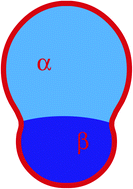Shapes of vesicles encapsulating two aqueous phases
Abstract
Motivated by recent experiments, vesicles encapsulating two aqueous phases are theoretically explored using a combination of Helfrich curvature elasticity theory for fluid membranes and self-consistent field theory for polymers. The spatial distributions of two polymers, α and β, have been obtained, and two thermodynamic phases occur, as expected. Stable or metastable shapes of fluid and closed vesicles have also been achieved. Due to the impenetrability of the membrane to polymer, the available spaces of polymers α and β are limited and the conformational entropies for the polymers are reduced. Different chain segments that possess different permeability to the membrane would induce different inhomogeneous entropic pressures on the membrane, thereby leading to shape transformations of the vesicles. In the present study, the typical shapes of vesicles encapsulating two phases are studied as functions of the concentrations of polymers α and β, and the interactions between the chain segments and the membrane. The two phases formed by polymers α and β are also found to be altered and have been discussed in detail. In addition, morphological phase diagrams are presented as a function of the reduced volume, v. The phase boundaries between oblates and prolates, and oblates and stomatocytes of vesicles encapsulating two phases are found to move toward the higher reduced volume, and oblates occupy a much wider range of the reduced volume compared with ‘neat’ vesicles.


 Please wait while we load your content...
Please wait while we load your content...